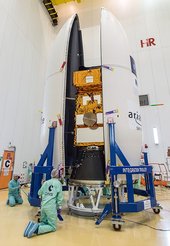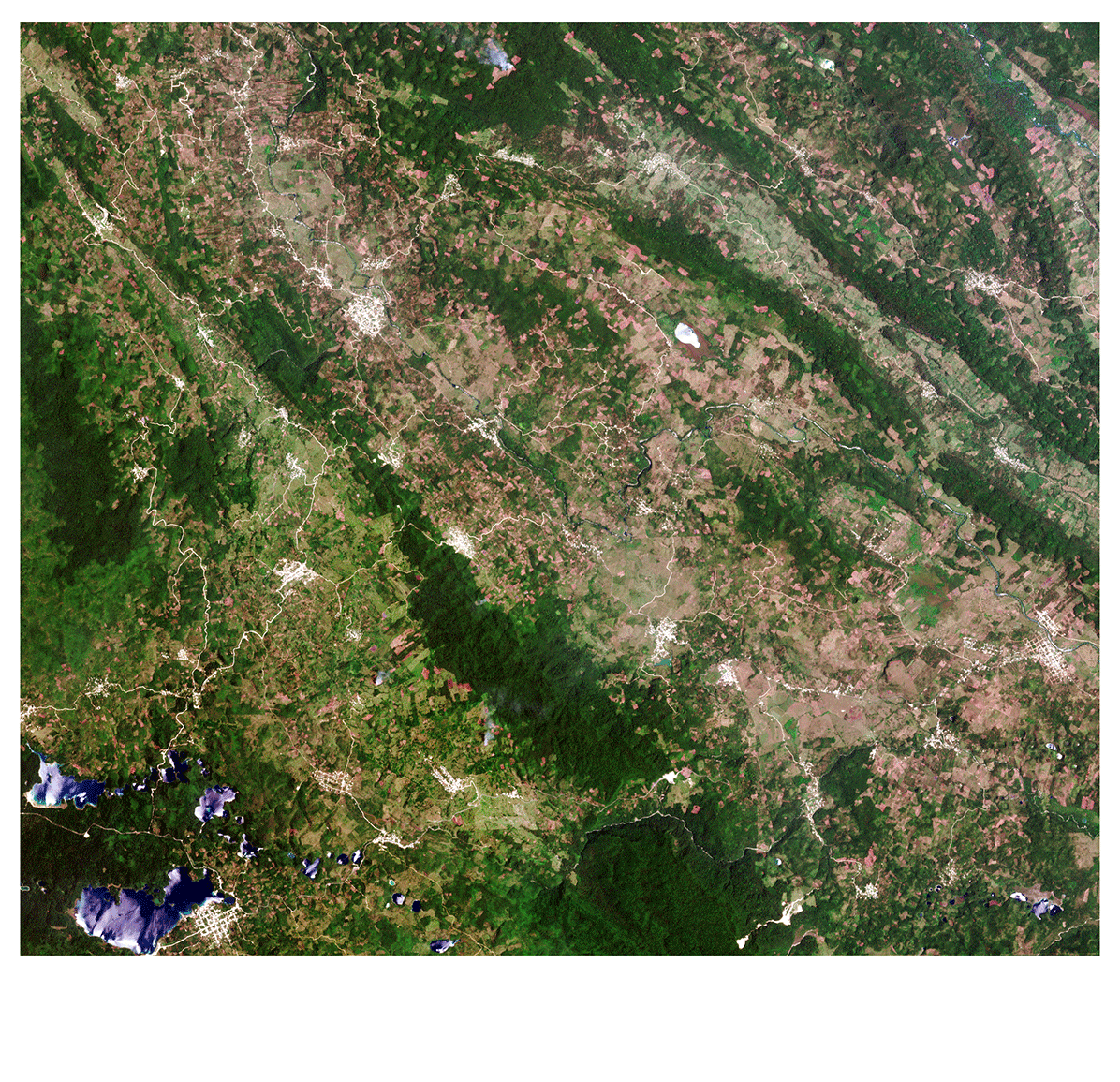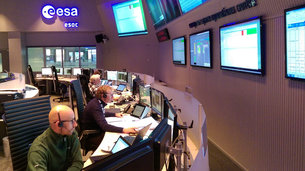http://www.esa.int/Our_Activities/Observing_the_Earth/Copernicus/Sentinel-2/Sentinel-2B_poised_for_liftoff
Sentinel-2B poised for liftoff
2 March 2017
With liftoff just few days away, the next Sentinel satellite for the Copernicus environmental monitoring programme is positioned in the launch tower at Europe’s Spaceport in Kourou, French Guiana.
Carrying a multispectral camera to image Earth’s changing land and vegetation, Sentinel-2B is set for launch on 7 March at 01:49 GMT (02:49 CET; 22:49 local time on 6 March).
It will join its twin, Sentinel-2A, which has been in orbit since June 2015. With them circling on opposite sides of Earth and each providing 290 km-wide coverage, the time it takes to image the globe will be cut in half to five days, and to just three days over Europe.
The satellite was shipped to Kourou in early January, where it has been tested, fuelled, encapsulated in its Vega rocket fairing, rolled out to the launch pad and hoisted into the tower.
The upper stage of the rocket has also been fuelled and the teams are now preparing for countdown.
Today, Arianespace, the Sentinel-2 team in Kourou and ESA’s mission control in Darmstadt, Germany, are performing a full rehearsal.
Paolo Laberinti, ESA’s Sentinel-2 launch campaign manager, said, “It’s been a very intense couple of months for the ESA and the Airbus Defences and Space team here in Kourou, but thoroughly checking and preparing the satellite for liftoff has gone very well and we are really looking forward to saying a fond farewell to our baby when it lifts off on Monday night.”
Francois Spoto, ESA’s Sentinel-2 project manager, added, “We’re were very proud to see the Sentinel-2A launch two years ago and now it’s almost time for Sentinel-2B to join its twin.
“The mission is not just down to us though, it is thanks to the close collaboration we have with the European Commission, an industrial consortium of about 60 companies led by Airbus Defence and Space, France’s CNES space agency and the Copernicus service providers – and I’m sure everyone is as excited as we are.”
As for all the Sentinel missions, Sentinel-2 has been built for the Copernicus programme, this time focusing largely on Earth’s vegetation.
Ensuring land is used sustainably while meeting the food and wood demands of a growing global population is one of today’s biggest challenges. The Copernicus land service provides information to help respond to global issues such as this, as well as local areas that are prone to specific challenges.
The state-of-the-art Sentinel-2 mission provides not only information to improve agricultural practices and map changes in land cover, but it also helps to monitor the world’s forests and to detect pollution in lakes and coastal waters.
In addition, images of floods, volcanic eruptions and landslides can contribute to disaster mapping and help humanitarian relief efforts.
Many of these applications rely on satellite images that are repeated very quickly – especially in the growing season. Once Sentinel-2B has been commissioned, users will have images of all Earth’s land surfaces, large islands, and inland and coastal waters between latitudes 84°S and 84°N every five days.
The Copernicus programme is led by the EU and the EC while ESA coordinates the Copernicus space component.
3 March 2017
Mission teams on two continents completed a pre-launch ‘dress rehearsal’ yesterday, ensuring everything is ready for Sentinel-2B liftoff next week.
A full dress rehearsal yesterday at ESA’s mission control centre in Darmstadt, Germany, and Europe’s Spaceport in Kourou, French Guiana, enabled teams to practice one final time the complete countdown and launch sequence before the real thing on 7 March.
Sentinel-2B is set for liftoff next Tuesday at 01:49 GMT (02:49 CET) on a Vega rocket, which will deliver the sophisticated Earth-watching satellite into orbit about an hour later.
In space, the new spacecraft will join its identical twin, launched in 2015, completing the two-ship constellation and effectively doubling the coverage provided by Europe’s ‘colour vision’ mission.
The two satellites will be placed in the same orbit, separated by 180° and, every five days, will jointly image land, large islands and inland and coastal waters, optimising global coverage and data delivery for numerous applications.
The two spacecraft are part of a new fleet of Sentinels that are delivering the data and images that are central to Europe’s ambitious Copernicus programme.
Final simulation training
In yesterday’s final ‘sim’, teams at ESA mission control worked with the joint ESA, Arianespace and industry launch team in Kourou to rehearse the launch sequence.
This included configuring the launcher and spacecraft for flight, stepping through the pre-launch countdown and then following the (simulated) flight of the Vega rocket and Sentinel-2B through to the receipt of first signals from the satellite and deployment of the solar array.
For ESA’s mission controllers, the dress rehearsal was the last in an intensive series spanning the past several months. During the rehearsal, engineers at ESOC received live signals from the satellite via an umbilical connection that will be disconnected shortly before launch.
Critical days
On Tuesday, the Vega rocket will provide Sentinel-2B with a spectacular ride into orbit, aiming to reach just below the final target of about 786 km altitude, where its twin is already flying.
The satellite will later use its propulsion thrusters to be nudged up to match Sentinel-2A’s altitude, with the two flying in a carefully planned constellation.
Mission controllers expect to receive the satellite’s first signals around 60 minutes after lift off.
Receipt of signals will mark the start of intense activity that will see teams working 24 hours a day to shepherd the new satellite through its first few critical days in orbit.
Engineers must ensure that the solar array has deployed so as to provide power, that the spacecraft is stable and properly oriented and that all systems are working as expected.
Teamwork
Yesterday’s rehearsal involved an extended ‘team of teams’ − satellite engineers, specialists working on tracking stations and on the sophisticated hardware and software used to control the satellite and distribute its data as well as experts working in areas like flight dynamics and training.
By next Friday, teams expect to have the craft configured for normal flight in its target orbit and to revert to normal work hours for the subsequent three-month satellite commissioning phase including the main imaging instrument (MSI) in-orbit verification.
Related articles

Sentinel-2B poised for liftoff02 March 2017

Sentinels warn of dangerous ice crack16 February 2017

Sentinel-2 teams prepare for space16 February 2017
ESA
Guillermo Gonzalo Sánchez Achutegui






No hay comentarios:
Publicar un comentario